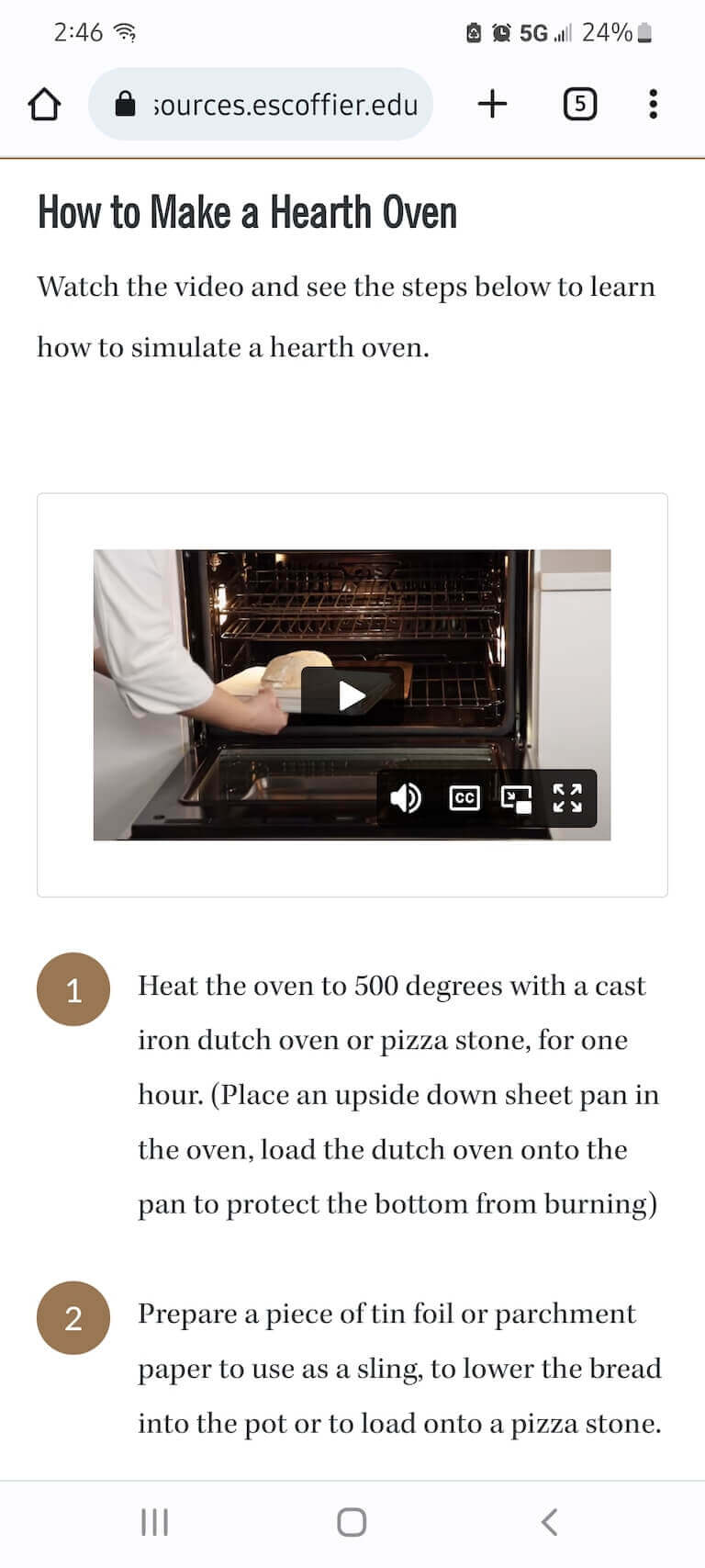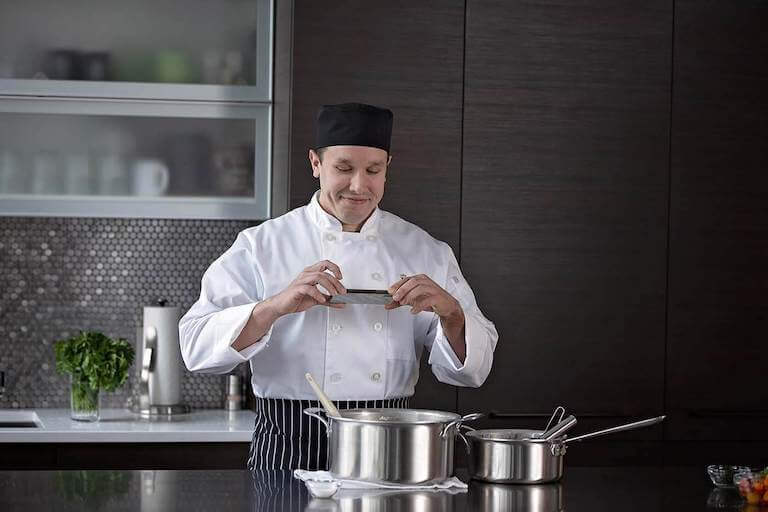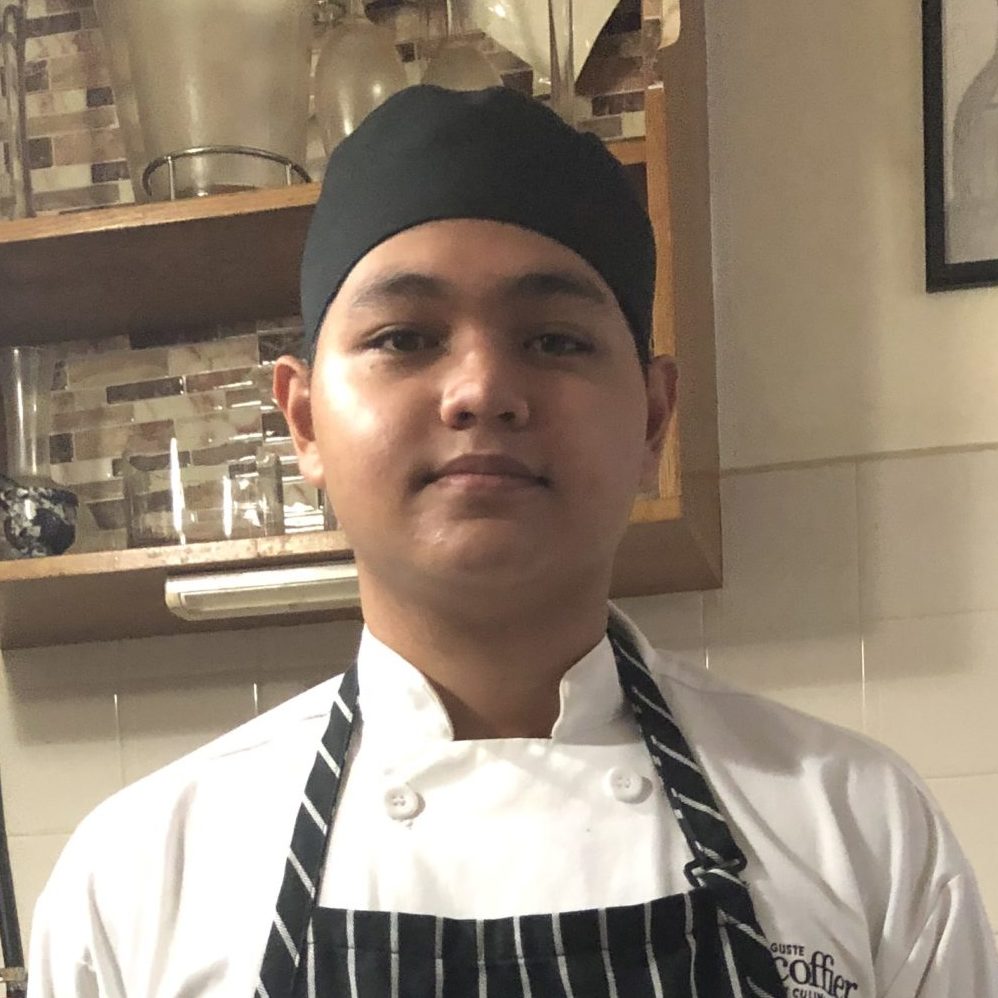As a culinary student, feedback from Chef Instructors can help you understand your mistakes and improve upon your skills in the kitchen. But how does the evaluation process work with online schools? Is it as accurate and useful as in-person feedback?
While working face-to-face with a Chef Instructor is certainly a great experience, many culinary enthusiasts could likely not earn a culinary school degree or diploma if the only way to learn was by attending in-person classes, due to busy work schedules or other commitments. And as you’ll see in this article, in-person learning is not the only option!
Online culinary and pastry arts programs are now available to anyone, anywhere, as long as they have reliable access to the Internet and meet the qualifications.
In this article, we’re going to outline how you get your assignments, record your process, submit your work, and get individualized feedback from your Chef Instructors during online culinary school.
But first, you’re probably still wondering…
How Can a Chef Instructor Evaluate Food Online When They Can’t Taste It?
As an online culinary student, you may be wondering how you will receive feedback from your instructors. Is it individualized? Will it help you improve the skills you may need to know to land a job at a restaurant or start your own catering business?
Auguste Escoffier School of Culinary Arts’ evaluation process provides students with one-on-one feedback for every assignment, reconstructing the cooking process and measuring against industry standards to provide the student with constructive feedback. Students are taught to build their flavor profile and describe what they are tasting by learning a common language through the use of Escoffier’s Flavor Wheel tool and by completing a critical thinking narrative describing their process.
Join Chef Luke as he discusses online culinary students and their food tasting process.
As Escoffier Chef Instructor Jesper Jonsson explains, “Most people, once you tell them that we teach culinary arts online, ask, ‘But you can’t taste the food. How do you know?’ The truth of the matter is I’ve seen so many steaks getting grilled that I know what the temperature of a pan sounds like. If I see a chicken breast, I can tell you if it’s dry on the inside. Then I can ask you what temperature did you cook it to? What was the carry-over temperature?” Professional chefs know that visual cues tell us whether or not cooks followed the proper method or procedure – color development, grill marks, and doneness are evaluated visually so that the chef doesn’t have to taste every item. After all, if you ordered a steak in a restaurant and it was served to you missing one bite, you’d wonder what was happening in that kitchen!
Because of the nature of the evaluation in our distance learning platform, Escoffier students are probably better at verbalizing what they’re doing and describing tastes. Was it salty? Was it bland? Was it tangy? And we use our flavor wheels for that. I think students being able to verbally describe foods and tastes has proven to be a tremendous asset.”*
Now that we’ve covered the “tasting” issue, let’s get into the details of how the evaluation process works in practice.
1. Get Your Assignment and Instructions
Each week in Escoffier’s online courses are built to accomplish specific learning objectives through various interactive learning aids which culminate in that week’s assignment.
The week includes online lessons and recommended readings, plus cooking demonstration videos of our Chef Instructors working in our professional demo kitchen. Students also attend the live online class sessions for further instruction or watch the replay if they are unable to attend live. They also interact with peers in our discussion forums and test their learning with quizzes on the material.
Culinary school classes are led by professional Chef Instructors from a variety of backgrounds and experiences. This means that students can have the opportunity to gain multiple perspectives on the culinary industry, as well as a variety of leadership and management styles.

Online students receive detailed instructions for each lesson and assignment.
Each assignment involves a list of required photos to record the process, plus a narrative and production sheet.
2. Record Your Process With Photos
Taking photos and recording your process allows your Chef Instructors to see the various steps you took to make the final dish. These photos serve to document the deconstructed, step-by-step approach the student took to their cooking process. It’s the Chef Instructor’s job to reconstruct that into an analysis of the work and provide constructive feedback, with the mindset of continuous growth of the student.
So what does visually capturing your assignments look like? Following the assignment instructions, you’ll take photos at specific steps of the preparation and cooking process. This can include how the space is set up, sanitary measures, preparing ingredients, specific cooking steps and procedures, and the overall outcome of the final product.

Students photograph their work and then submit their photos for feedback.
3. Submit Your Assignment with a Document Explaining the Experience
The narrative and production sheet both provide students with a space to write down how their cooking or baking process went. Students can comment on what worked well, and where they might need more guidance.
“I encourage anyone who wants to invest in their culinary career to attend Auguste Escoffier School of Culinary Arts! Their online program is top-tier, and the staff work tirelessly to support students because our success is theirs, too.”*
Shamaya Williams Coats, Escoffier Online Culinary Arts Graduate
Students can also use a flavor wheel to describe their dishes. The flavor wheel includes aroma (e.g., berry-like versus onion-like), mouthfeel (e.g., juicy or dry), and taste (astringent, tangy, etc.). Assignments are submitted through Escoffier’s Learning Management System, which can be accessed through a computer or mobile device.
4. Get Feedback From a Professional Chef Instructor
After submitting an assignment, students get a feedback video from their Chef Instructors. This is where instructors point out what went well, what could be improved for next time, and any tips or tricks that they personally use when working on this item again.
Most importantly, Chef Instructors offer encouragement and provide opportunities for students to ask questions. Students can email, text, and call their instructors, and set up one-on-one appointments with them for deeper discussions.
“There was one time when I made veloute, one of the mother sauces. I thought it tasted fine, but when I smelled it, it came off a little bit smoky, so I wrote it down. My Chef Instructor gave me feedback by looking at the pictures of my sauce. He noticed the moments it began burning from the pictures that I didn’t really notice. But he was able to catch it, see where I went wrong, and correct me along the way.”*
Damian Palacios, Online Culinary Arts Student
Your Industry Externship Provides Opportunities for More Feedback
The culinary externship is a practical, hands-on placement in a professional kitchen. Completing an approved industry externship is the final required component of an Escoffier student’s curriculum before graduation.
While a student’s duties may vary depending on their externship site, all externships offer an opportunity for students to practice skills and receive feedback from chefs and cooks working in an ongoing operation.
“I felt capable outside the box (of my home), and during my externship I had the proof! I was asked to fulfill tasks that made me realize that I did have confidence and knowledge thanks to the Escoffier program and its amazing Chefs.”*
Susanna Halbrook, Escoffier Online Culinary Arts Graduate
Are You Ready For Guidance From Professional Chef Instructors?
Too many people put their culinary or pastry arts dreams on hold, believing that face-to-face training is required to advance their culinary skills. In this article, we’ve shown that the online, distance learning format can allow passionate students to explore new skills and techniques, and take the first step to accomplishing their dreams.
Whether you want to open your own restaurant, work as an executive chef, or build another exciting food-based career, you don’t have to wait. A quality education with world-class chef instruction is available now, online.
Take the next step and get a plan to learn how you can turn your passion for food into a new career and life.
Read more about how online culinary and pastry arts programs work:
- A Day in the Life of an Online Culinary Student
- Yes, Online Culinary School Works. Here’s How
- How Online Pastry School Works
*Information may not reflect every student’s experience. Results and outcomes may be based on several factors, such as geographical region or previous experience.
This article was originally published on February 5, 2021, and has since been updated.

 “There was one time when I made veloute, one of the mother sauces. I thought it tasted fine, but when I smelled it, it came off a little bit smoky, so I wrote it down. My Chef Instructor gave me feedback by looking at the pictures of my sauce. He noticed the moments it began burning from the pictures that I didn’t really notice. But he was able to catch it, see where I went wrong, and correct me along the way.”*
“There was one time when I made veloute, one of the mother sauces. I thought it tasted fine, but when I smelled it, it came off a little bit smoky, so I wrote it down. My Chef Instructor gave me feedback by looking at the pictures of my sauce. He noticed the moments it began burning from the pictures that I didn’t really notice. But he was able to catch it, see where I went wrong, and correct me along the way.”*